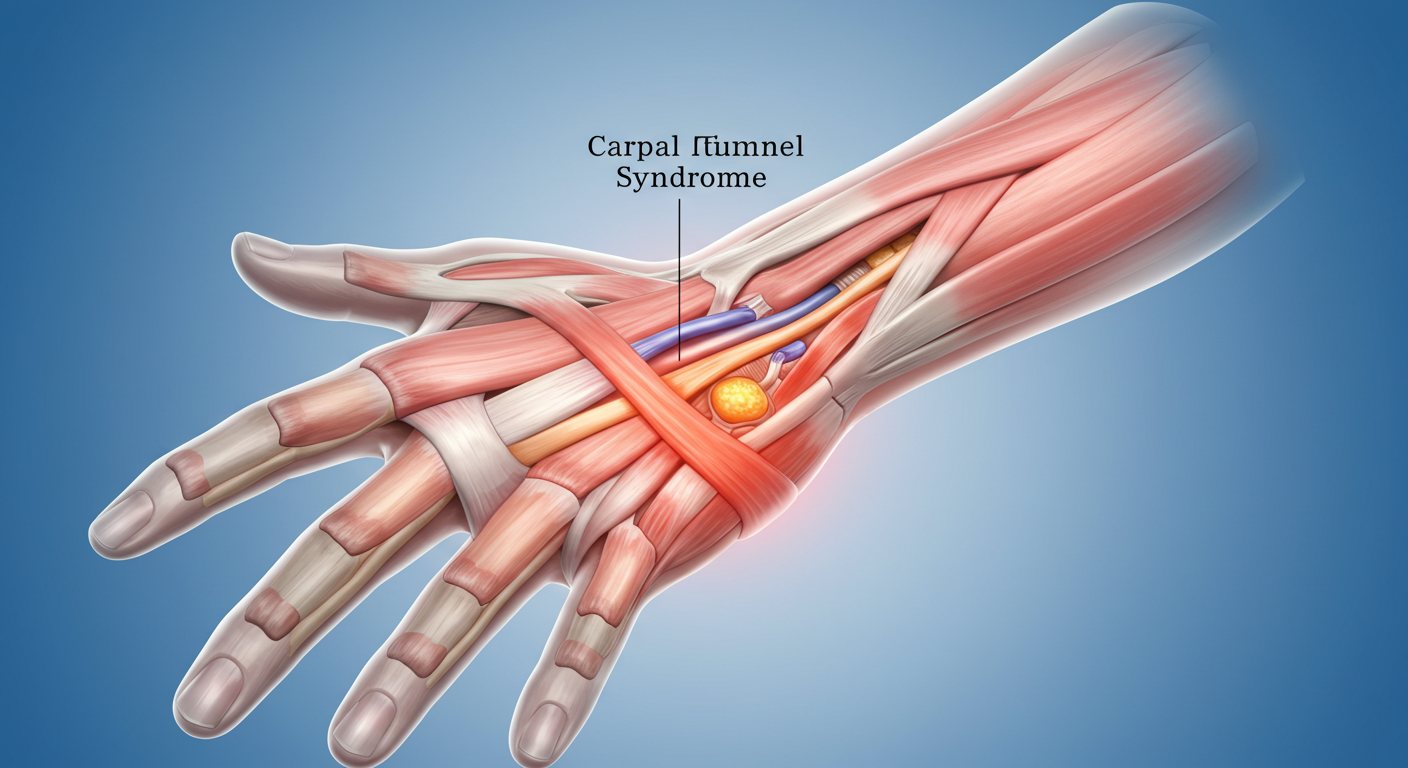End Carpal Tunnel Pain, the best at-home treatment guide. That tingling, numb feeling creeping into your hand and fingers? If it’s disrupting your day or even keeping you up at night, you might be dealing with carpal tunnel syndrome. The good news is, that catching it early means there are plenty of things you can try at home to find relief.
So, What Exactly IS Carpal Tunnel Syndrome?
Imagine a narrow tunnel in your wrist – that’s the carpal tunnel. Inside lives your median nerve, which is kind of a big deal because it provides feeling to your thumb, index, middle, and part of your ring finger. Carpal Tunnel Syndrome (CTS) happens when that nerve gets squeezed, usually because the tissues around it are swollen, or the tunnel itself has narrowed. Think of it like a crowded subway car during rush hour – not a happy place for anyone involved!

What Causes This Squeeze, Anyway? (Risk Factors)
The way you’re built: Some of us are just born with a smaller carpal tunnel. Also, if you’ve ever broken or dislocated your wrist, that can change the tunnel’s shape and up your risk.
- Being female: Yes, women are more likely to get CTS, possibly because, on average, we have smaller carpal tunnels than men. Thanks, biology!
- Underlying Health Stuff: Conditions like arthritis, diabetes, and even thyroid problems can play a role. Pregnancy, with all its lovely swelling, can also put pressure on that median nerve.
- Doing Too Much, Too Often: Repetitive hand and wrist movements – especially if you’re using vibrating tools – can definitely contribute. Think assembly line work, constant typing, or even certain hobbies.
What Does Carpal Tunnel Feel Like? (Symptoms)
The symptoms usually creep up on you slowly:
- That classic numbness, tingling, burning, or pain mainly in your thumb, index, middle, and ring fingers. It’s like pins and needles, but not in a fun way.
- Occasional “electric shock” sensations that shoot down into those fingers.
- Sometimes, the pain or tingling can travel up your forearm towards your shoulder. Ugh.
- Your hand might feel weak and clumsy, making it hard to do things that need fine motor skills, like buttoning a shirt or picking up small objects.
- Ever found yourself dropping things for no reason? That could be due to weakness, numbness, or just not having a good sense of where your hand is in space.
Your At-Home Carpal Tunnel Toolkit: Relief is Possible!
If your symptoms are mild to moderate, you can try several things at home to ease the squeeze on that median nerve:
- Take a Break, Already! Seriously, listen to your body. If an activity is making your wrist hurt, cut back or stop altogether. Whether you’re glued to your keyboard, rocking out on your guitar, or DIY-ing with hand tools, schedule regular breaks to give your hands a rest.
- Ice, Ice, Baby! Ice packs or an ice bath for 10-15 minutes, once or twice an hour, can work wonders for reducing pain and swelling.
- Splint It to Win It! Wearing a wrist splint – especially at night – keeps your wrist in a neutral position and prevents you from bending or flexing it while you sleep. This is HUGE, especially during pregnancy because it’s a medication-free way to get relief.
- Shake It Like a Polaroid Picture: Woke up with that awful nighttime pain? Gently shake your hand and wrist to help relieve the pressure.
- Warm It Up: Sometimes, soaking your hands in warm water can be soothing and provide relief.
- Pop a Pill (But Ask Your Doc First): Over-the-counter pain relievers like ibuprofen (Advil, Motrin) or naproxen (Aleve) can help with the pain. But, chat with your doctor before taking them, especially if you have other health conditions or are on other meds.
- Get Moving: Specific exercises and stretches can improve grip strength and ease the pain
- Namaste Your Way to Relief: Yep, yoga! Certain yoga poses can stretch and strengthen your wrists, which may help reduce pain.
When Home Remedies Aren’t Enough: Escalating Treatment
If you’ve tried the DIY route and still aren’t feeling better, it might be time to consider more intensive treatments:
- Cortisone Shots: A doctor can inject a corticosteroid (like cortisone) right into the carpal tunnel to reduce inflammation and give the nerve some breathing room. This is often a temporary fix, though.
- Surgery: If your symptoms are severe or just won’t respond to anything else, surgery might be the answer. It usually involves cutting the carpal ligament to release the pressure on the median nerve. Sounds scary, but it’s often very effective.
- Hand Therapy, the Next Level: A physical or occupational therapist can teach you advanced exercises to relax your hands and give you longer-lasting relief.
The Bottom Line: Don’t tough it out! If you’re experiencing persistent carpal tunnel symptoms that are interfering with your life, see a doctor. Early diagnosis and treatment can help prevent permanent nerve damage. Your hands will thank you!
Also Read | High Morning Blood Sugar: Understanding and Managing the Dawn Phenomenon







